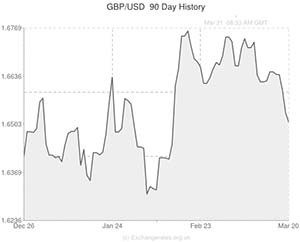
The Pound to US Dollar exchange rate (GBP/USD) tumbled to a fresh monthly low of 1.6480 yesterday as markets continued to reshuffle their positions following Federal Reserve Chairwoman Janet Yellen’s hawkish policy statement yesterday.
The US Dollar advanced against the Pound on Wednesday evening when the US Central Bank announced that it was to reduce the pace of its monthly asset purchasing scheme from $65 billion to $55 billion. That much was expected. Already priced into the market.
However, traders were not expecting Yellen to bring forward the predicted date of the first Fed rate hike. The Central Bank Chairwoman said that interest rates would “probably” be raised around “six months” after the quantitative easing programme was fully wound down.
The way things are going, with QE3 being tapered at each of the last three policy meetings – December, January and March – it is looking increasingly likely that the asset purchasing venture could be finished by October of this year. This raises the possibility of a rate hike as early as April 2015, which is basically the same time that the Bank of England is expected to raise rates.
Sterling has rallied by around 15 cents against the ‘Greenback’ over the last twelve months, and the most recent chunks of those gains were heavily influenced by rate hike speculation. This is because the rapid expansion of the UK economy and swift improvements in the British labour market were seen to put the BoE on course to tighten monetary policy before the Fed.
Now that markets are forecasting rate hikes from both the Fed and the BoE at around the same time it is much less likely that the Pound will be able to continue its ascent against the US Dollar.
Even if the QE3 programme lasts until December, as some analysts expect it to, the “six month” revelation means that interest rates in America would probably be raised in June next year – just a few months after the Bank of England.
The Federal Reserve’s hawkish outlook was justified somewhat yesterday, as US Jobless Claims came in encouragingly at 320,000, Leading Indicators more than doubled the market consensus at 0.5% and the Philadelphia Fed index printed at a 9-month high of +9.0, up from -6.3 the previous month. All of which bolstered demand for the US Dollar.
In contrast, the Pound was hurt slightly by a drop in the Confederation of British Industry’s (CBI) export orders index. Whereas 27% of firms reported below average orders in February, only 18% witnessed above average orders, which sent the export index down to -10, from -1 previously.
With all things considered it doesn’t look like the Pound to US Dollar exchange rate (GBP/USD) will have the legs to reach 1.6800, a level it reached around a month ago, again.
However, there are two things that could significantly boost the GBP/USD outlook.
One would be a statement from Janet Yellen indicating that she does not expect rates to be increased as early as markets currently predict.
The other would be a significant improvement in the UK labour market in the next few months, involving wage increases above the rate of inflation, rapid full-time job creation and a dip in the headline Unemployment Rate below 6.5%.
Whilst the UK labour market does look in relatively good shape at the moment, it is unlikely that such a profound improvement will be witnessed over the next few months. However, bearing in mind Yellen’s famously dovish predisposition, it is slightly more possible that the Fed Chair will look to calm market chatter with a clarifying statement.

Comments are closed.